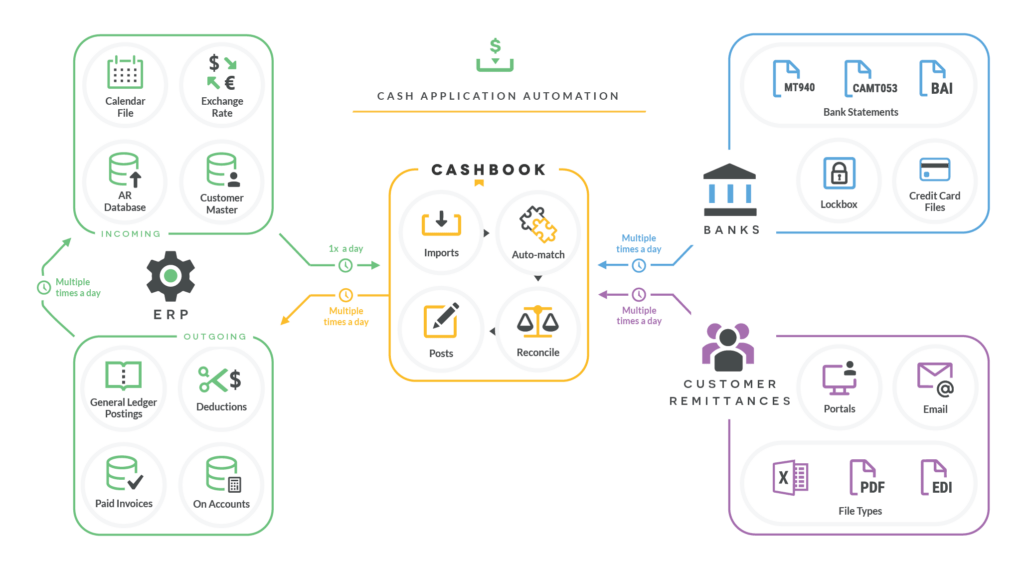June 23rd, 2022
Applying Cash: Essential facts and why it’s so important
‘Applying cash’ is a term used to describe when companies manage their Accounts Receivable. Another term that is used to describe this process is Cash Application. In this article, we give you the essential facts about applying cash, and why it’s so important for organizations to get it right.
What does ‘applying cash’ mean?
Essentially, applying cash is the part of Accounts Receivable management where inbound customer payments are matched to remittance information, and to the corresponding open invoices. It is a key cog in the full order-to-cash cycle wheel. The main goal is to process all inbound payments and close all of the open invoices in your Enterprise Resource Planning (ERP) system. We look further now at what’s involved in this process.
Elements and stages involved in the Cash Application process
The three main elements involved in the cash application process are payments, remittances, and invoices. We take a look at each of these in more detail below.
Payment: This is the payment made by the buyer to the supplier. The cash application team will receive the exact payment detail from banks. These payments can be made in multiple ways such as Checks, Wire Transfers, ACH, SEPA, Credit Cards, and Ghost Cards.
Remittance: A remittance is essentially the data as to why the payment is being made. It can include as little or as much payment information as possible, some electronic payments have no remittance advice. Data included could be invoice numbers, amounts, codes, deduction information, and notes. Remittances can be uploaded to web portals for retrieval or they can also be sent via e-mail. Remittance file types include Excel, PDF, Image-based, and EDI files.
Invoice: The invoice is what was initially sent to the buyer to request the payment. Your AR team would prepare the invoice for goods/services rendered and send it to your customer. The cash application team will use the payment and remittance data above to match the payment to the correct invoice.
The typical stages of applying cash in a company are as follows:
- AR Team sends out all invoices to buyers.
- The buyer makes the payment in one of the numerous ways.
- The customer sends the remittance data to you.
- AR team receives the payment data from the bank.
- AR team ‘matches’ the payment and remittance data to the specific open invoices.
- Payment is recorded as received, invoices are closed out, and the ERP system is updated.
Key challenges of applying cash
There are some key challenges to the cash application process for companies. Below we look at some of these in more detail.
Decoupled Remittances:
Previously, when payment methods were few, it was easier to process the payments received and match them to invoices. This was mainly because checks were commonly used and contained very specific remittance data. Today, there are multiple ways to make payments, some have sufficient remittance data and some have little to none – making it harder to match to invoices. Today the remittance data and payment are separate, they have to be identified as a pair firstly before matching to an invoice.
Lockbox Banking Fees:
Lockbox banking helps companies streamline the deposit and processing of checks into their accounts. Banks collect checks from a designated address, usually a P.O. Box, and will process them on your behalf. This can be quite an expensive service for companies. Once lodgements are made, the bank will send a lockbox file of total deposits. This file will be used by your AR team in conjunction with a BAI2 file, also provided by the bank, to match deposits against open AR invoices. The data can be incomplete and it can be a demanding manual process going through the individual images.
Deductions Management:
Customers can make a reduced payment of the invoice which is known as a deduction, this can be done for a number of reasons. Such as damaged goods or late delivery, they may decide to only pay 80% of the invoice total. It is up to the supplier to investigate if this is a legitimate claim and to take action accordingly. It can be very time-consuming to investigate these individually, especially if you have thousands of invoices every month. The loss to the bottom line can be significant.
Poor AR processes can affect other internal departments:
If it’s taking your AR team longer than usual to process payments received, this can have a detrimental effect on other teams in the company such as Credit and Collections. They may be unaware that a customer has already paid because it hasn’t been processed yet. Collections may reach out to the customer looking for a payment they made already. This can lead to unhappy customers and a bad customer experience.
Why ‘applying cash’ efficiently is so important
As we have seen above, there are many complexities and challenges around applying cash. It is very important for a company to meet these challenges head-on, and develop the most efficient AR process possible for their particular business. Below are some key reasons why having an efficient accounts receivable process is so important to an organization.
- Having a streamlined AR process is key to having a steady cash flow.
- Having consistent cash flow in your company is key to long-term company health.
- Applying cash as quickly and accurately as possible is a key goal for AR teams.
- Getting money into company bank accounts faster reduces Days Sales Outstanding (DSO).
- Improve your AR processes while avoiding costly manual errors.
- Improved customer experience and business relationships.
Best way to improve the cash application process
The best way to improve your accounts receivable process is through the use of AR automation software. Technology has advanced over the last 10 years to a degree now where it’s more surprising if a company is still using archaic methods of applying cash, as opposed to using AR automation software. Business leaders and forward-thinking CFO’s have adopted cash automation technology with the aim of improving company growth.

Benefits of automating the cash application process
- Remittances will be auto-matched against open invoices and bank statements.
- Eliminate expensive bank lockbox key-in fees.
- Deduction management process improved – more cash reclaimed.
- Faster speed of processing – higher automatic matching rates, reduced DSO.
- Improved cashflows and future planning – better company health.
- Improved AR accuracy – remove manual errors that cause real problems.
- Automatic updating of the ERP and General Ledger.
Contact Us
If you would like to discover how Cashbook can help automate the cash application process. Please contact our team by calling +353 61 338 400 (International) or 630-352-2228 (North America). Alternatively, you can email info@cashbook.com. We look forward to talking with you and helping your company realize the benefits of cash automation technology first hand.




